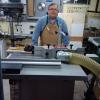We have all seen Norm do this several times. He runs a board against the fence (vertically) through the dado, flips it around and runs it through again to “center” the dado.
Now, I haven’t done this yet (haven’t needed too), but if you just cut a ¼ dado in the stock and flip it and it were to shave some more off to “center” the dado. Wouldn’t your dado be larger than you want?
I may have just answered my own question, but it should be all relative to how you have your fence set, correct? In other words, if your fence is set to the exact half width of the stock to the center of the blade it shouldn’t matter.
Am I thinking about this correctly? Food for thought





 Reply With Quote
Reply With Quote






